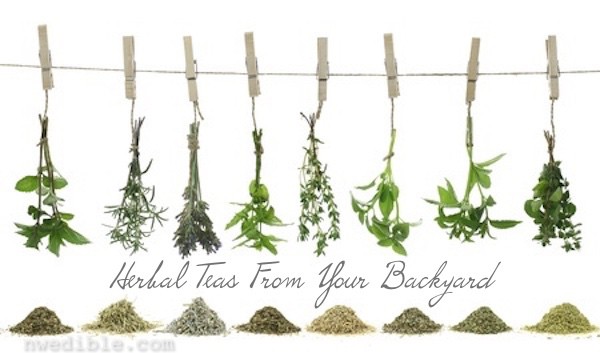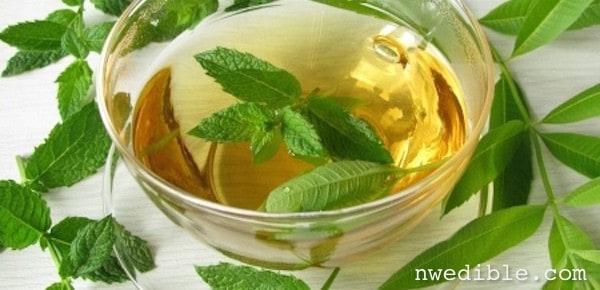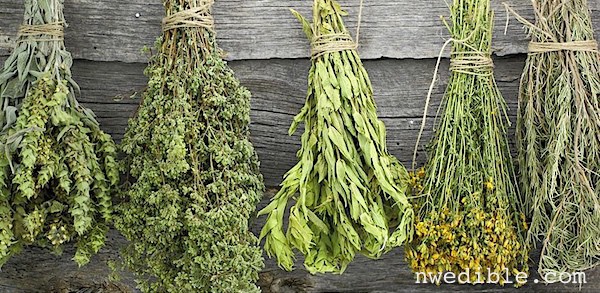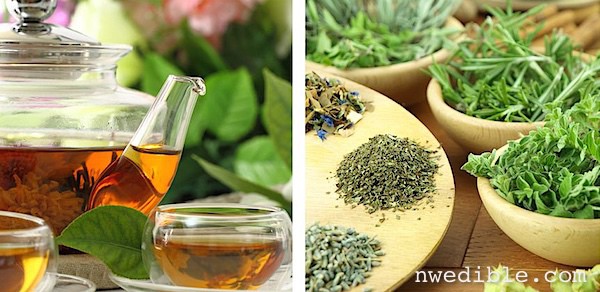
I’m a Seattle-girl to the core, so I’m not giving up my coffee any time soon.
But I also have a big, soft place in my heart for a steaming mug of herbal tea, especially when I can grow and dry the herbs myself.
The Basics
Herbal tea isn’t technically tea, since it doesn’t contain the leaf of the tea plant, Camellia sinensis. But rather than debate the minutia of infusions and tisanes, I’d rather just get to the good stuff: how to make your own herbal tea.
Fresh herbal tea is one of the seasonal benefits of being an herb grower. Last summer I had a pair of big, thriving lemon verbena plants, and when I wanted a lemony tea it was as easy as dropping several leaves of fresh verbena into a mug of hot water and waiting for a few minutes.
Fresh herbs typically have more vibrant, punchy flavors, but for convenience and year round herbal tea enjoyment most people will want to dry their tea herbs.
Typically, 5 or 6 leaves of fresh herbs like mint or verbena are sufficient to make a cup of tea. When using dried herbs, 1 tablespoon of lightly crushed herbs per big mug of tea is a good rule of thumb.
Don’t boil herbs. Instead, pour nearly boiling water over herbs and let your tea steep for 5 to 10 minutes.
If you don’t (or can’t) grow your own herbs, my readers love Mountain Rose Herbs, and Amazon has a pretty comprehensive selection of bulk herbs too.

Getting The Best Flavor…
…in your dried tea herbs is mostly about capturing and preserving the most essential flavor and aroma compounds.
Harvest At The Right Time
For most herbs harvested for their leaves this is just before the plant starts to flower. When harvesting flower buds, as with lavender, harvest when the buds fatten up, but before flowers open.
The essential oil components of most herbs are highest in the morning. Ideally, cut the herb after any nighttime moisture has dried, but before the day heats up.
Dry Gently
To preserve the best flavor and aroma, dry your tea herbs very gently as whole leaves right on the stem.
I tie several stems of cut herbs together into a bundle, then hang the bundle upside down someplace shaded until the herbs are shatteringly crisp.
I have a covered back patio that has good airflow but doesn’t get hit with direct sun that’s perfect for drying herbs. I’ve also tied bundles to cabinet pulls in my kitchen to dry, and hung herbs from shelves in the pantry and garage.
You can also dry herbs flat, in a single layer on a mesh screen. Again, you want good airflow and to keep the herbs out of direct sunlight.
I don’t bother using my food dehydrator for herbs, but if you harvest herbs when it’s raining or very high humidity (try not too!) you might need to. Use the lowest possibly temperature setting, and pull your herbs as soon as they are crisp.

Start…Simple
A “simple” is an herbal tea made from just one herb. I think the reasoning on the name is pretty obvious. Simples are a great way to begin your DIY Tea Adventure.
Great single herb teas include:
- Chamomile
- Hibiscus
- Lemon Balm
- Lemon Verbena
- Peppermint
- Raspberry Leaf
- Spearmint
- Chocolate Mint
Blend It Up
Here’s where it gets fun. By combining multiple herbs into a blend, you can make your own unique herbal tea blends.
When designing your herbal tea blend, it simplifies things to think it terms of flavor profiles. Please note these guidelines are given from a culinary perspective. There are herbal-medicinal situations where people might choose to make an pure infusion of dandelion, for example. I’m not suggesting that’s a bad idea, I just don’t think it’s the most tasty.

The Mints
A good solid base for a tea, the mints are calming, cooling and refreshing, all at once. Use a single mint or a blend of several. The mints can make up to 100% of your herbal tea blend.
- Peppermint
- Spearmint
- Chocolate Mint
- Orange Mint
- And many, many more. Use your favorite, selecting for big, strong mints that can stand up to drying.
The Citruses
Like the mints, citrus herbs are easy-going and play well with other, so they make a good base flavor for a herbal tea. When dried, the citrus herbs loose some of their fresh punchiness. They can be used, singly or blended together at up to 100% of your blend.
- Lemon Balm
- Lemon Verbena
- Lemongrass
- Lemon Thyme
The Berries
You can add a ripe, berry-like quality to a tea without using actual berries. Both leaves and blossoms of raspberry, blackberry and strawberry plants add mild fruitiness to teas, and raspberry and blackberry leaves have a tannin profile similar to black tea, which makes them an excellent base for a caffeine free herbal tea that taste more like, you know, real tea.
I typically use the leaf, because I want those blossoms to become berries. Use up to 100% as a base, or blend at around 50% equally with mild florals and mints for a soothing brew.
- Raspberry Leaf and/or Blossom
- Blackberry Leaf and/or Blossom
- Strawberry Leaf and/or Blossom
The Florals
Although all these have a flowery quality, they are a diverse group in terms of strength, lavender and rose petal should be used in small quantities – 5% to perhaps 10% of a blend – until you are sure you like the flavor they give. Too much rose or lavender is a sure fire way to make a tea taste like grandma’s soap.
Elderflower and chamomile are much more versatile, and can be used up to 100% in a tea, though I think really lovely results are achieved by blending elderflower blossom at 50% with blackberry leaf.
- Lavender
- Rose Petal
- Elderflower Blossom
- Chamomile Blossom
The Zingers
A certain commercial tea brand has a whole series of teas called “Zingers.” Well, the zing in zingers comes from hibiscus blossoms. Both hibiscus and rose hip are very high in Vitamin C, and add a pleasant puckery, floral-citrus flavor to teas. They also both add a gorgeous pink hue to your cup. If you are looking to ward off scurvy or battle the common cold, either can be made at 100% as a simple, but I think they’re best at about 25% to 50% of a tea blend.
- Hibiscus
- Rose Hips
The Resins
Here’s a flavor profile that calls for a light hand. The resinous, citrus and pine quality of these ingredients can add a deep, almost mysterious and wintery quality to an herb blend, or they can make you think you’re licking an evergreen scented car air freshener. Try the resins at up to about 10% in a blend made mostly of mint, with perhaps a little citrus added to lighten things up. If you like that resin note, go heavier.
- Rosemary
- Sage
- Pine Needle – While most pine needles are safe to steep, certain varieties of pine are toxic or can cause miscarriage in pregnant women. Make sure you can properly identify safe varieties before consuming.
- Fir Needle
The Greens
Mild and generally medicinal, these herbs typically add a fresh hay or cut grass flavor to tea. They are nice in the background, at about 25% of an herbal blend of mostly citrus and mint. The resins and strong florals can accent the greens very well.
- Nettle
- Sweet Woodruff
- Dandelion
- Comfrey Leaf – check with a qualified herbalist or your doctor before using comfrey internally. Comfrey contains compounds that can cause liver damage.
- Clover
The Sweets
Stevia is called “sweet leaf” for good reason – chewing on it gives you a burst of slightly licoricey sweetness. I grow a stevia plant in a pot about every other year, when I remember to, and the dried leaves are an excellent addition to tea blends, especially with fruity and minty base herbs. Fennel and the basils aren’t nearly so powerful, but still contribute a nice green, mild licorice, sweet background note to tea. Use just a bit of stevia, and up to 50% of the other sweet herbs.
- Stevia Leaf
- Bronze Fennel
- Sweet Basil
- Holy Basil
- Thai Basil
- Anise Hyssop
The Soothers
These guys aren’t so much a flavor category as an effect category. The soothers are added to calm you down, relax you and get you ready to sleep.
With the exception of chamomile, which is mild enough for regular use as a single-herb simple, all these herbs can act powerfully enough upon the central nervous system that side effects can be dangerous. That’s not to say you should never use them – just talk to a knowledgeable herbalist first about dose and be respectful.
- Chamomile
- Valerian Root
- Hop Blossom
- Passiflora Blossom
- Catnip
- Linden Flower
Beyond Herbs!
Adding dried fruit, berries and spices to your herbal tea opens up whole new worlds of flavor potential.
Berries
Pretty much any berry tastes great in tea. Dry, then chop into small pieces as needed.
- Blackberries
- Cranberries
- Cherries
- Raspberries
- Blueberries
- Currants
- Elderberries
- Mulberries
Fruit
Larger fruit can be peeled, cored or pitted as needed, cut into bite-sized pieces and dehydrated in pieces.
- Apples
- Peaches
- Apricots
- Plums
- Mango
Spices
These are a great addition to tea blends, but go easy – spices infuse strong and fast; herbs are slower. If you get the blend wrong you might lose your herbs in the mix. You can find the right flavor for you by adding spices to single mugs of base teas rather than mixing a big batch all at once.
Excellent tea spices include the sweet and cookie spices, along with anything citrus-derived.
- Cardamom
- Clove
- Nutmeg
- Cinnamon
- Orange peel
- Lemon peel
- Ginger
- Fennel Seed
- Star Anise
- Corriander

DIY Tea Recipes
Want a little guidance in putting it all together? Here are a few herbal tea blends I’ve made and enjoyed.
Simple Everyday Herbal Tea
I always have way too much of both these base herbs, but luckily they make a mild and easy drinking everyday tea.
- A base of equal parts lemon balm and peppermint
- Just a bit of rosemary
Basic Fruity Zinger Tea
A zinger-y hibiscus base can be easily modified. Just add dried fruit, berries or spices as you like.
- A base of equal parts hibiscus, rose hips, blackberry leaf and raspberry leaf
- A bit of dried lemon peel and stevia
- Dried berries, fruit, and spices to make it your own
Cold and Flu Fighter
Long on Vitamin C, this is a good one to make up in the fall when cold season hits.
- A base of equal parts lemon balm, rosehips, hibiscus, anise hyssop and elderberries.
- A bit of stevia for sweetening and a teeny pinch of cayenne pepper if you can handle it.
Tummy Soother
Bad belly? Try this. Mostly mint, with a good dose of ginger, this helps with digestion.
- A base of about 60% peppermint, 20% raspberry leaves and 20% anise hyssop
- A generous addition of dried ginger and a bit of dried orange peel.
Trouble With The Lady Parts Tea
Raspberry leaves are a traditional cure-all for pretty much any female-specific complaint. PMS? Menstrual cramps? Morning sickness? Untoned uterus (huh)? If it’s specific to the female anatomy, chances are raspberry leaf will be recommended.
- A base of 100% raspberry leaf
- Stevia, to sweeten and a good pinch of dried willow bark (optional, for pain relief – the pain reliever in aspirin is derived from willow bark.)
- A giant chocolate bar. (Serve this on the side. It has nothing to do with the tea, but it is also medicinal for lady parts trouble. That’s my story and I’m sticking to it.)
Relaxation Tea
Chamomile tea is my favorite mild herbal sedative. I never worry if the dose is off. Because we grow hops and use them in homebrewing, I’ve made this tea with and without hops. Hops do conk you out, and are also pretty bitter. Use at your own discretion.
- A base of 50% chamomile flowers, 25% spearmint and 25% lemon verbena
- Stevia to sweeten and a small pinch of dried hop blossoms (optional)
–>Your Favorite Here<–
Seriously, herbal tea blends are easy! Don’t overcomplicate this – just spoon a few leaves in a mug, fill with hot water, and steep for 5 or 10 minutes. That’s all there is to it!
Wow! Is there anything you don’t know about?? Thanks for sharing. Hubs and I recently started getting into teas and were considering growing some mint this year. This will be a great help to us.
Hah! Yes, tons and tons. Like how to keep a four year old asleep past 4:30 am…. 😉
I have a 4 year old grandson with the same problem. Please post if you ever discover the answer!
Perfect! This post is just in time for me! I drink chamomile most evenings and peppermint or other herbal teas throughout the day, but the only tea I’ve ever made is a simple mint tea. I used to work in a fancy tea shop and we sold a dizzying amount of teas.
For years I had leftovers in my cabinets. I was just looking at my tea cabinet forlornly yesterday as my leftovers are mostly gone except for about an ounce of stale “mystery tea.” I used to love a lavender tea we had called “lavender lace” that had lavender of course, but also cinnamon and other spices. I am going to try to recreate it.
Any tips on growing this stuff? I only have a balcony (here in Seattle), so not tons of light or space.
In Seattle most of the common perennial herbs are pretty easy to grow if you have some sun and soil with decent drainage. Several herbs are reasonably easy to keep alive in a pot: mint, lemon balm, rosemary (get a dwarf or trailing variety), sage and lavender among them. The larger the pot, the better. If you don’t have much sun, mint and lemon balm will still grow fine in half sun.
Thanks so much! I think I will give this a try.
Brilliant article! Thanks SO much! I’m thrilled to learn there’s a delicious use for raspberry leaves! And the other varieties sound fabulous as well. Now I know what herbs to plant in my garden ninja patch! 🙂
Thanks for suggesting this topic!
Here’s a funny note about ” Lady Trouble” that has nothing to do with tea:. Someplace I used to live there was a long-gone diner that had the “PMS Plate”. It was:
A pile of very thinly sliced rare roast beef
Fresh Brussels Sprouts, oven roasted with shallots
BBQ potato chips
And a glass of milk. And they wouldn’t give you a fork; you were supposed to use your fingers for the ” primal experience”. Then there was very fudge chocolate cake and more milk. It was awesome and actually did the trick
That’s hilarious!
You astonish me with your knowledge yet again! Is there nothing don’t already know about?! We make a basic anise seed tea quite often for tummy upset, works great! 1/2 a teaspoon seeds in hot water. I will also make anise tea with honey for the kids and I if we have a sore throat, as well. We buy anise seed from the Hispanic section of the grocery store (ahem – vastly cheaper!), one packet will last forever. In most Latin American countries, they will sell anise tea at a very expensive price, but you get the exact same taste and quality with just simple seeds in water. As a side note, it’s not star anise, which has a much stronger flavor, just straight anise seeds. We go through a lot of anise anyway, since we also use the seeds as a flavoring for one of our favorite breads – chipa, which is just milk, queso fresco, egg, tapioca flour, and anise or rosemary for flavor. Mixes up in 10 minutes, and bakes for about that long. So yummy! Hot anise chipa is great with a bit of jam on a cold day, with a cup of anise tea 🙂
I am totally ignorant of many, many things, but thankfully culinary herbs are in the category of things I know a little about! A regular reader emailed and requested this topic and I was like, “Wow, that’s a really good idea. I can’t believe I haven’t yammered about herbal tea yet.” 🙂 Good tip about the anise seed. Sounds delicious.
What a fantastic article. Thank you for this!
Thanks Vy.
Sassafras and Licorice root for me. I mostly use dried sassafras leaf, the twigs I add sometimes but are slightly more resiny while the leaves are softer and more “green.”
I know there are questions on risks with sassafras, but from what I can tell, the concern is safrole oil, concentrated mostly in the roots, and it also is found in certain basils and other herbs that are used regularly without any problem.
I like my tea and have no intention of avoiding it, but did want to mention the risk so others are informed. I find that it is somewhat similar to chamomile in calming effect, but I am not sure whether this is placebo or not…
Ah, good additions. Those would be purchase-items for me. I have no idea how to grow licorice root, but I’ve had it in store bought tea and enjoyed it. If I’m remembering correctly, licorice is common in throat soothing blends along with slippery elm. Hmmm….might have to track some down.
Great post, Erica! Just few mentions:
As you posted, pregnant women, in general, should be cautious about drinking copious amounts of herbal tea because some herbs are strong emmenoagogues – plants that can induce or increase menstrual flow. Delicious raspberry leaf tea is best avoided in the first trimester.
Lactating moms should be aware of effects on their nursing babies and again be cautious and do some research.
Valerian root, a very effective sedating herb, can have the opposite effect in a small percentage of the population.
Avoid using storebought dried herbs as most have been sprayed with pesticides, are often quite old and in some cases, irridiated.
Lastly, some herb teas can have a drying/astringing effect on our organs causing increased activity…if you get my drift. 🙂
Thank you for weighing in, Sue! Wanna be our resident Herbalist? 😉
These things are why I hesitate to start using herbals or essential oils. I am a mishmash of symptoms/medicines/supplements already. How do I know what interacts with metformin? d-Chiro inositol supplementation? Progesterone/HCG/Femara supplementation at strategic points in my cycle? What will help PCOS? What will help infertility? When and how much? Before ovulation? After ovulation? Skip two weeks then load up? So confused.
If you try to do research on the internet, every article looks copy and pasted with the same information. How do you know if that is correct, or if people are copying incorrect information into all their blog posts?
In that kind of situation, you really have to talk to a qualified herbalist who can help you with a more custom approach. In the meantime, a cup of peppermint tea isn’t going to hurt. 😉
cptacek:
You are right to be cautious – herbs can be powerful and some can interfere with pharmecuticals. It’s important to note that modern Western medicine has advanced knowledge and treatments that are far more effective and/or practical. And traditional medicine (herbalism) has many strengths in specific areas.
Do not use the internet as a source of information for such a complex situation like yours. There is so much garbage on herbs that I want to scream some times! Find an herbalist who is well-educated in the field of fertility and work with her/him. You can start your search at for a professional clinical herbalist here: http://www.americanherbalistsguild.com/
Best of luck,
Sue
Thank you, Sue, for the link.
Under the resins section, be aware that the needles from the ubiquitous yew trees (which a lot of people think are firs), are poisonous. They’re awfully pretty with their bright green needles and gorgeous little red berries, but don’t make tea with it.
I should have called that out specifically. Thanks for adding it. Never consume yew, people!
Fine article, thank you. One note, a young foxglove (before it puts up a flower stalk) looks like a comfrey plant. Since foxglove is digitalis, a tea made from it might have a bad effect on the heart.
Yup. Wildcrafting requires you can correctly identify plants. Very true.
Young foxglove also looks like sage (or so Agatha Christie novels have led me to believe). Since I have a lot of volunteer foxglove, sage gets grown inside.
Great topic, Erica! Thank you!
I grew some chamomile last year and come of the tea was delicious and some was bitter. I’m wondering if that was because of the age of the flowers and/or the time of day of picking? I tried to harvest in the early morning but sometimes life gets in the way, and… well, you know.
My daughter was asking me about growing chamomile this year in her garden. I’m going to send her the link to this article!
I had chamomile tea for the first time this past year. The strangest thing happened. I took a drink, and immediately was reminded of sitting on the top of a wheat truck in 102* heat in the middle of Kansas, while Dad dumped wheat from the combine into the truck. We used to grab handfuls of wheat from the back of the truck and chew it, chew it, chew it, never swallowing, until we made a gum out of it. (A weak gum, with no flavor, but something you could kinda sorta chew).
I thought that was weird. So I took another sip. Instantly, another flashback to the wheat field. Every time I took a sip, it reminded me so strongly of the hot, humid, dusty wheat. It was crazy.
I would add calendula flowers.
Be careful with raspberry leaf. Besides effects for pregnant women (ask your doctor), it often causes a drop in blood pressure. This is often considered a point in its favor, but is an unpleasant surprise if your BP is already low.
Home-mixed teas are twice as satisfying, though!
Wow! A great article.Will be trying a few of those combos.
I’d like to add one: Lady’s Mantles (for what I know, all those species). Whether you are having menstruation or menopause troubles, it’s good.
It’s a good idea for start a new business with green tea, or we can make money very easy way. I loves the green tea from daily use milk tea. We can lose and maintain body with the help of different type of taste Nice post thanks for share it.
Thank you for this tutorial. Just what I have been looking for. I’m grateful that you broke it down into percentages of how much to use. Very helpful.